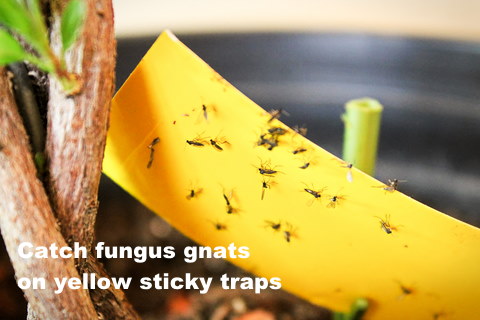How to Get Rid of Fungus Gnats
Discover how to get rid of fungus gnats on your indoor plants. Here, you'll find out how to identify these pesky insects, where they come from, and the safest, best ways to kill them indoors.
What Fungus Gnats Look Like
Fungus gnats look like tiny, black flies with grayish transparent wings. The adults are about 1/16-in (.2 cm) long and have long legs and antennae.
Being so small, they can enter a home through the tiniest of openings. Fungus gnats can sneak indoors through open doors and windows, then take up residence on the moist potting mix of house plants. They sometimes arrive in a newly purchased bag of potting mix, or on a new houseplant.
They're more of an annoyance than anything. They are harmless to humans, and unlike many house plant pests, the adult gnats don't feed on plants. They're attracted to moist organic matter such as peat moss and fir bark in many potting mixes, and overwatered plants will draw them...well, like flies.
Life Cycle of a Fungus Gnat
Now you're wondering...why treat my plants?
The fungus gnat life cycle is quick and they may take over your whole plant collection if left untreated.
Most of these insects are females that will lay 100-300 eggs in crevices of the soil. The eggs hatch into larvae in 4-6 days and feed on plant roots, damaging your plants and leaving them susceptible to disease.
After feeding for a couple weeks, they go through a pupal stage in the soil. In less than a week, they emerge as adults to begin the cycle all over again.

Where to Find Fungus Gnats
Although they have wings, they can barely fly. You'll find the gnats crawling on the soil or hovering just above the soil surface. Because they are dark like soil, they are difficult to detect unless they are moving. You'll see them stir if you blow on your plant or when you water it.
Seedlings and moisture-loving plants such as African violets and ferns are a favorite home for these pests. Overwatered plants are also a haven for them.
Disclosure: Guide-to-Houseplants.com participates in affiliate programs offered by the advertisers featured here. If you make a purchase after following the links on this page, I may receive a commission at no additional cost to you.
Green Thumb Tip
Treat your plant as soon as you notice the infestation. Although these tiny pests seem harmless, they reproduce quickly and will invade your other houseplants, carrying any plant disease from one plant to another.
How to Get Rid of Fungus Gnats on Houseplants
Controlling these insects can be as simple as allowing the soil to dry out between waterings. If your plant will tolerate dry soil for a short time, this may be the solution. I tried this on my heartleaf philodendron. I stopped watering it for 2 weeks to let the soil dry out and the gnats just disappeared. If your plant is not drought-tolerant, try one of the other solutions.
You can catch the adult insects by staking a yellow sticky trap in each infested plant container. This will catch the adults, but not the larvae. Insecticidal soaps labeled for fungus gnats can be used for killing the adult insects.
Bonide® Insecticidal Soap Ready to Use Spray is a safe, effective way for killing gnat larvae on house plants. Apply as needed to stop the life cycle. Read the label carefully and follow the manufacturer's directions for use.


